Behind every attractive garden is a gardener trying their best to keep pests away. Pests don’t always mean bugs; in a lot of cases, deer can be just as destructive to gardens as an infestation of aphids or beetles. This can mean a lot of maintenance towards keeping these flowers intact. Planting deer-resistant flowers saves a lot of time, energy, frustration, and maintenance.
Zinnias are a beautiful, deer-resistant flower option for gardeners. They are colorful with over 100 different varieties to choose from to add to any outdoor landscape.
Zinnias are not the only flower that is deer resistant. Below you’ll find 35 more flowers to choose from that are bound to hold up to wandering deer.
1. Peonies (Paeonia officinalis)
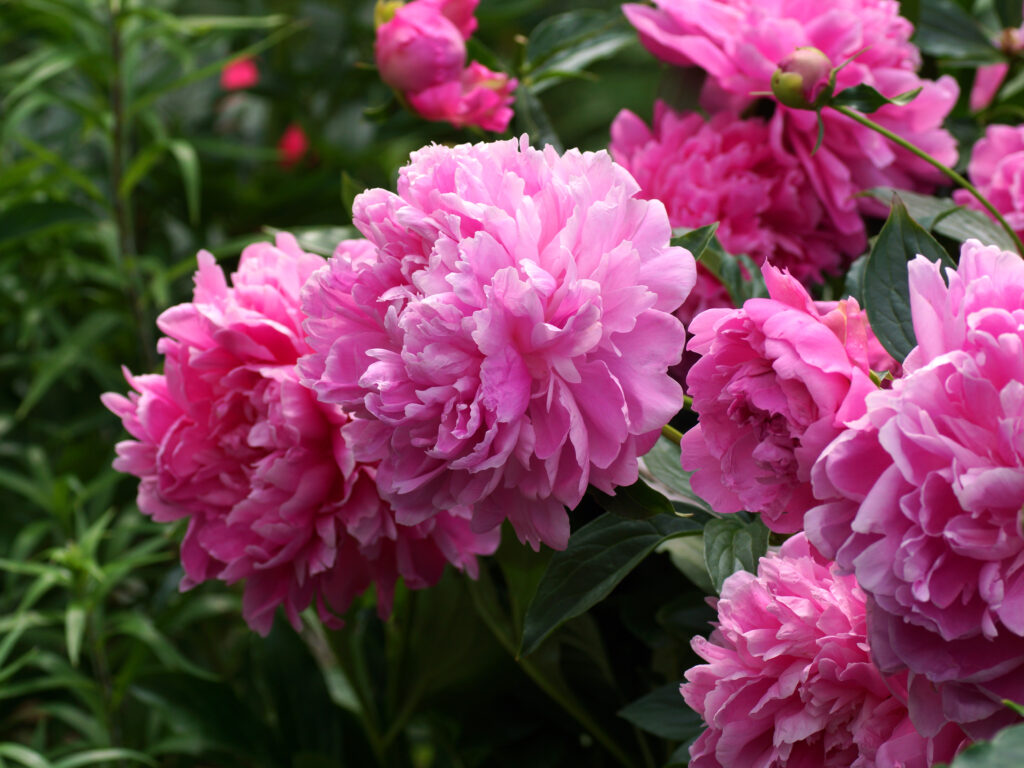
These large-blossomed flowers have dark green foliage throughout the year.
©Natali22206/Shutterstock.com
Peonies are such a classic, elegant flower to have in your yard. They are long-lived perennial plants that can live to be over a century old with the right love and care. Deer, however, will stay clear of these fragrant beauties. Their pungent, floral odor deters them from grazing. Peonies grow best in zones 3-9. Size-wise, these bushes can grow to be 3-4 feet wide.
2. Rosemary (Rosmarinus officinalis)

Rosemary is an herb in the Salvia family Lamiaceae, which has many other deer-resistant plants.
©Maren Winter/Shutterstock.com
This is a dual-purpose plant any gardener should consider adding to their deer-resistant flower arsenal. The plant itself is a culinary herb and its tiny purple flowers wonderfully accent the olive-green, upright spikes of foliage. But the best reason to plant rosemary is because its strong scent is unpalatable to deer, so you don’t have to worry about this plant being eaten by anyone but you.
This is also a good plant to use as a border for other plants that might be susceptible to deer grazing, like roses. Rosemary can be easily grown in almost any region. If you’re outside of zones 6-10, consider growing it in a container so you can bring it indoors for the winter months.
3. Butterfly Bush

Once you plant a
butterfly
bush, be prepared for an influx of butterflies when this plant flowers!
©iStock.com/lantapix
As the name suggests, the butterfly bush is a great plant for pollinators (and gardeners). This plant blooms wonderful floral spikes which can come in shades of pinks, blues, and purples. Like many other plants on this list, the heavy scent carried by this bush that attracts pollinators is also what detracts deer.
Butterfly bushes grow best in zones 5-9. To keep this plant from getting somewhat invasive in your garden, deadhead the spent blooms to keep them from re-seeding.
4. Lavender (Lavandula spp.)
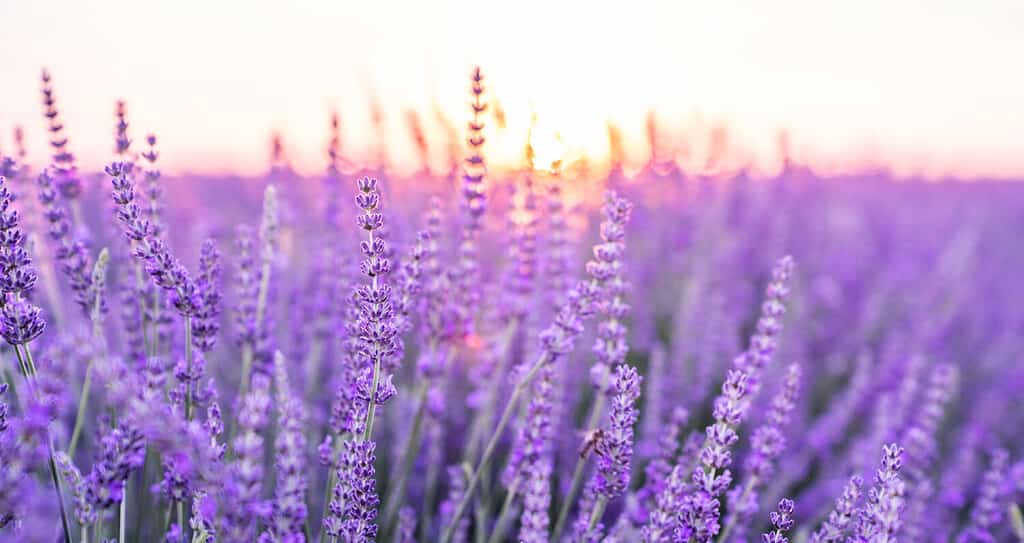
The lavender plant prefers warm climates similar to the Mediterranean region .
©ESstock/Shutterstock.com
Strongly scented herbs are some of the best deer-resistant flowers to plant, and lavender is an exceptional example. There are a few different types, from English to Spanish lavender, and both are stunning to humans but awful in the eyes of deer. Lavender plants tend to bloom in the springtime in zones 5-9. Despite the name, lavender can come in different shades of purple, pink, and even white. Prepare for most lavender plants to grow about 2 feet tall and wide.
5. Sunflowers (Helianus annuus)

These plants are called sunflowers not for their color, but because they track the sun during the day.
©Pablesku/Shutterstock.com
Sunflowers, unlike many other plants on this list, are not fragrant. These tall beauties instead deter deer with their harsh leaves and hairy stems. Deer don’t care too much for chewing on plants like this, so they would rather move onto softer, more palatable plants elsewhere.
A sunflower patch or row would make for a great border to increase the privacy of your garden. Since they can grow up to 6 feet tall (15 feet if you choose one of the taller-growing types) they can also add some shade to areas of your garden that might get too harsh of light. Sunflowers can also grow just about anywhere! They are hardy between zones 2-11.
6. Bearded Iris
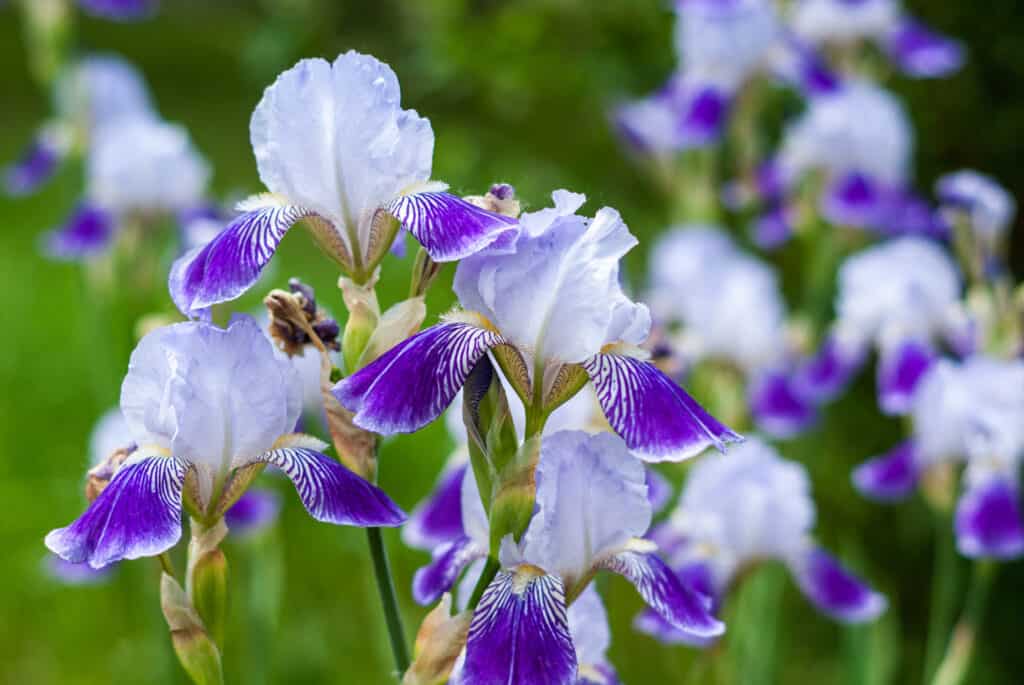
Flowers will appear in the early parts of spring throughout the growing season depending on your region.
©iStock.com/Natalya Mamaeva
The bearded iris is named for the lower petal that hangs down past the other bright purple petals. It’s a gorgeous flower that comes in more than the purple color it’s known for and is deer resistant. If the smell of the iris wasn’t enough to deter a deer, the taste would!
Bearded irises can be grown in zones 3-9. Warmer zones will see flowers earlier in the season and possibly again later before fall.
7. Bee Balm (Monarda spp.)
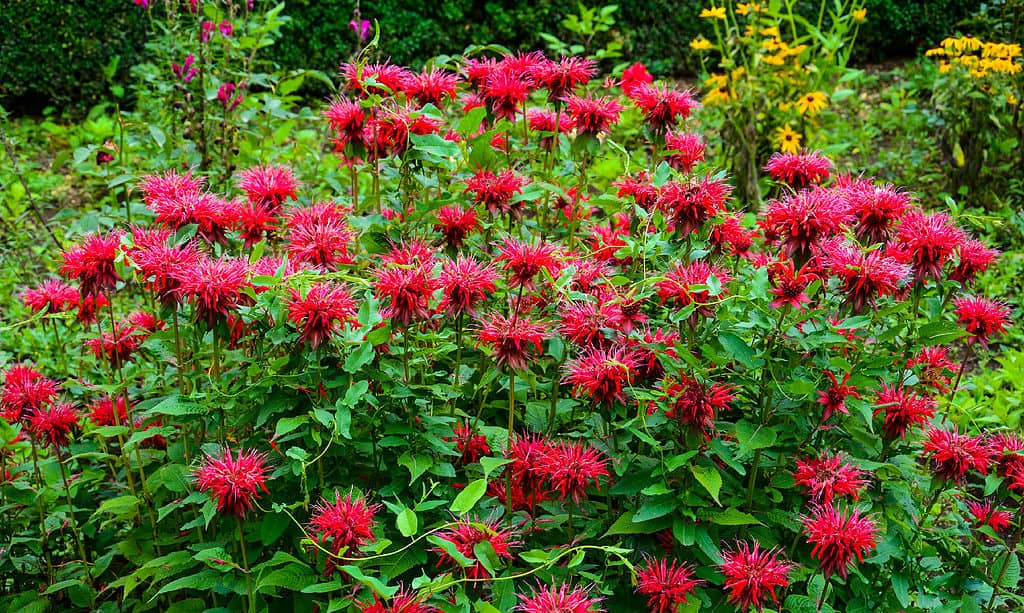
The long petals of bee balm contrast beautifully with the deeply serrated leaves.
©Vahan Abrahamyan/Shutterstock.com
The bee balm plant is another go-to for those who love keeping a safe space for bees. Other pollinators enjoy the sweet smell of the flowers. As is the theme with deer-resistant plants, the strong odor so many insects love is exactly what keeps the deer away! Bee balm does best in areas with low humidity but can thrive just about anywhere within zones 3-9. This is also a winter-hardy plant that will die back in the cold months but re-emerge during the spring.
8. Catmint

Catmint has fuzzy leaves and cute, tubular-shaped purple flowers.
©iStock.com/Akchamczuk
Like other members of the mint family, catmint is a strong, odorous plant. The scent of this plant isn’t just going to keep away deer but can also protect other plants from many types of beetles and aphids. If you’re a cat lover, then you also have a cat-friendly plant to give to your feline friend! The small purple flowers can attract butterflies and many native bees.
Catmint can grow vigorously, so if you grow it outdoors, consider planting it in a pot and then into the ground. This will help keep the roots from popping up everywhere in your garden. It is a good border plant and handles drought well. Catmint is best grown in zones 3-8.
9. Hellebore (Hellebore niger)
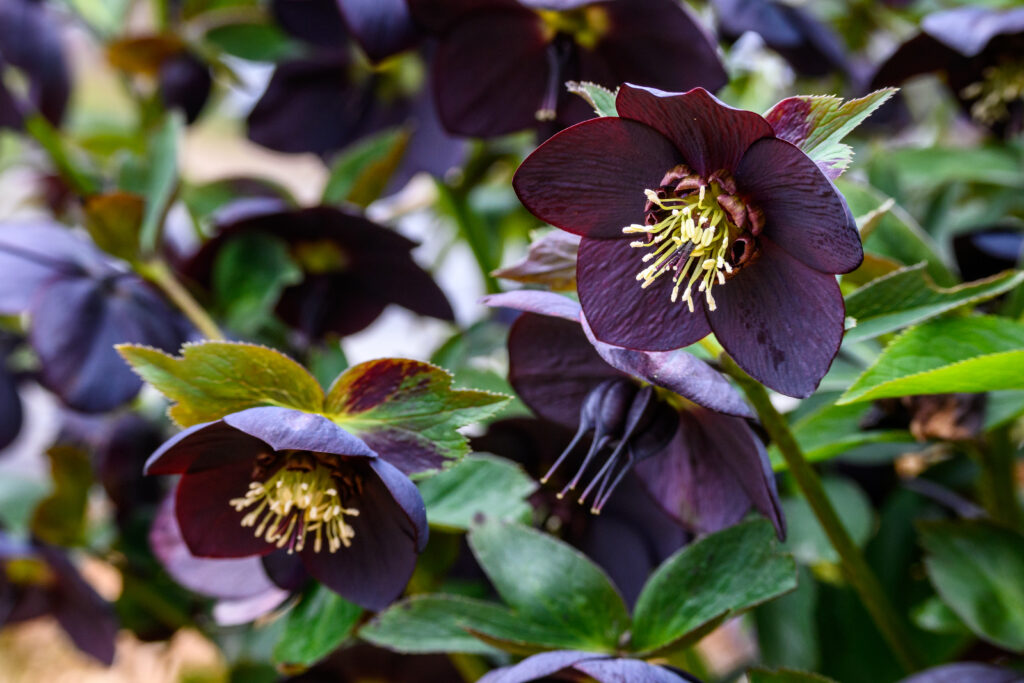
Hellebores can be white, pink, and even a deep purple.
©knelson20/Shutterstock.com
Also known as the Christmas rose, this deer-resistant flower blooms late in the year. In addition to its unique flowers similar to if a rose and hibiscus hybridized, the dark green palm-shaped leaves give some extra “oomph” to its appearance. Deer will not go after this plant because it is poisonous.
Hellebores can live in zones 3-9 and will keep their dramatic leaves through the winter.
10. Bleeding Heart (Dicentra spectabilis)
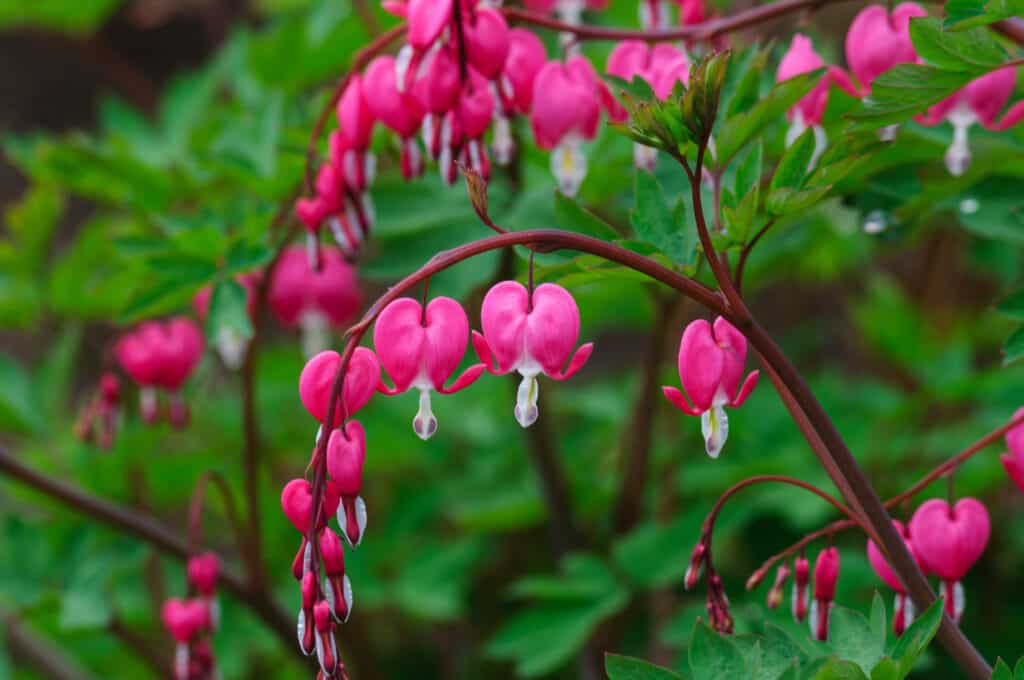
The bleeding-heart plant is a favorite because of its brightly colored and odd-shaped flowers.
©Vahan Abrahamyan/Shutterstock.com
The appearance of the bleeding-heart flower is not the only thing that’s interesting about this plant. It is not one that interests rabbits or deer, only the human gaze. Additionally, this plant will lose its flowers and leaves in the summer. It is highly shade tolerant, so be sure it’s getting plenty of shade in order to produce those striking flowers.
You can grow this flower in zones 3-9.
11. Calendula (Calendula officinalis)

Calendula is an herb frequently used in teas.
©Yulia_B/Shutterstock.com
Though they might not look it, calendula flowers are especially bitter. Some people enjoy these flowers added to a salad, though deer would prefer not to have this flower anywhere near their next meal. Calendula flowers are great for having color throughout your garden for the entire growing season, but only if you live in warm regions of zones 9-11.
12. Foxglove (Digitalis spp.)
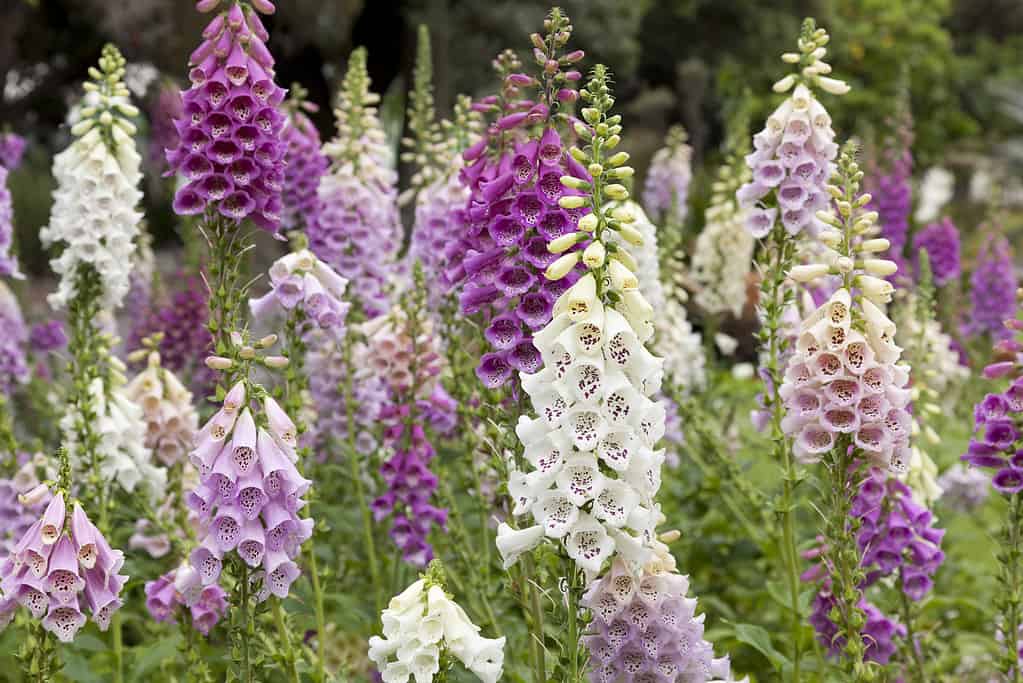
The compound found in foxglove, Digotoxin, has been studied to aid in assisting those with heart issues.
©PicturePartners/iStock via Getty Images
You won’t see deer going after their toxic flowers, but you will probably catch some bees getting deep into the bell-shaped flowers for pollen. They can grow over 5 feet tall, making them a pretty and useful plant to add for privacy. Since this plant is toxic to deer, it is also toxic to other animals and humans too. Only grow this plant if you can be sure no animals or people will be tempted to ingest it.
13. Oriental Poppies (Papaver orientale)

There are many different varieties of oriental poppies to bring different colors to your garden.
©Ole Schoener/Shutterstock.com
Poppies are a favorite flower of many for their variety in color and pattern. They have a short window of flowering but that is part of what makes these flowers so tantalizing. Like other toxic plants on this list, deer know to steer clear. Children and household pets might not, however, so exercise caution when growing poppies.
Along with a short flowering period, their growing zone is pretty small too. These perennial, deer-resistant flowers grow best in zones 6-8.
14. Daffodils (Narcissus spp.)

Also known by its Latin name, daffodils can look very frilly depending on the cultivar you get.
©steshs/Shutterstock.com
Daffodils are bulbs that are amongst the first flowers in the spring. They exude a milky latex substance that deters foraging pests like deer and squirrels. Daffodils can be grown in a wide range of the United States from zones 3-8. Since they are bulbs, they will come back year after year to greet you and the first signs of spring promptly.
15. Lungworts (Pulmonaria spp.)
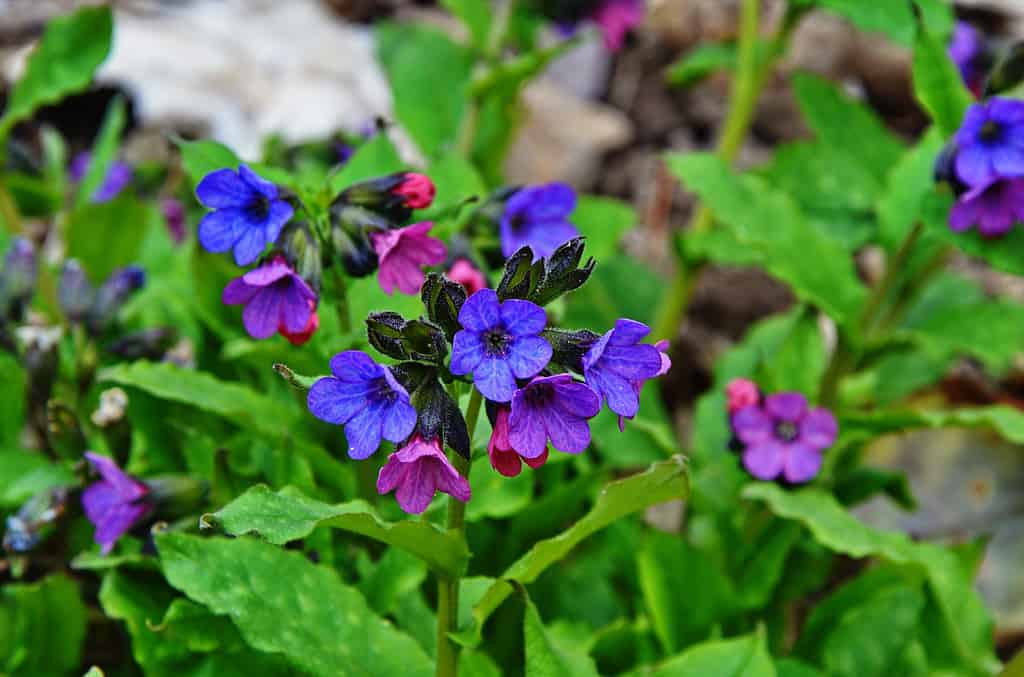
The common name for this flower comes from the leaves, which resemble diseased lungs.
©weha/Shutterstock.com
Deer and rabbits tend to stay away from lungworts because of their hairy exterior. Lungworts are a fun addition to your outdoor space because one plant can have multiple different colors of flowers on it. They’re also available to grow in colder zones, from 2-8.
These plants can reach up to 2 feet in height and width, so be sure you’re giving enough space between plants if you use them as a border plant.
16. Astilbe (Astilbe spp.)

Astilbes are often called “false goat beard” plants.
©Tanya_Terekhina/Shutterstock.com
The deer-resistant flowers on an astible plant look very soft and inviting to pollinators but not to grazing animals. Astilbes are best grown in areas that get a bit of shade, which is contrary to most flowering plants.
Astilbes are another plant that is slightly more winter-hardy than others, performing well in zones 3-8.
17. Autumn Sage (Salvia greggii)

Much like other members of the
Salviagenus, the tube-shaped flowers are a favorite for butterflies.
©Nahhan/ via Getty Images
The autumn sage plant can be used as a border plant for other garden beds to help keep away deer, elk, and rabbits with its powerful scent. While deterring unwanted creatures it will attract beneficial ones to your garden. It might be useful to keep some of these pollinator plants near fruit and vegetable gardens to attract pollinators.
Autumn sage will bloom around late spring into the fall until the first frost. Grow in zones 6-9 for best results.
18. Chamomile (Matricaria chamomilla)
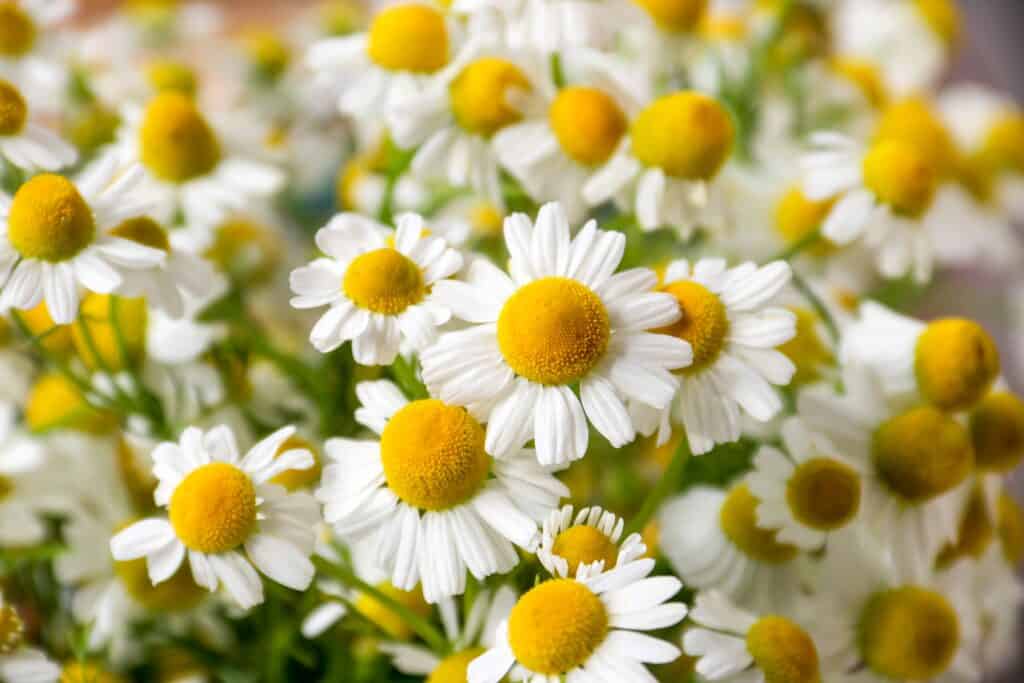
The chamomile flower is frequently visited by butterflies and bees.
©Olesya Myzzz/Shutterstock.com
Chamomile flowers are often made into a tea, used for its calming properties. Not only can you have unlimited chamomile tea, but the aroma this plant exudes makes it a great deer-resistant flower. The scent itself is calming to humans, and the dainty white flowers with yellow centers can also give a sense of “zen” to those who witness them. It can grow up to 2 feet tall.
Roman and German chamomile prefer warmer climates. Zones 6-9 are the most appropriate for these flowers.
19. Breckland Thyme (Thymus serpyllum)
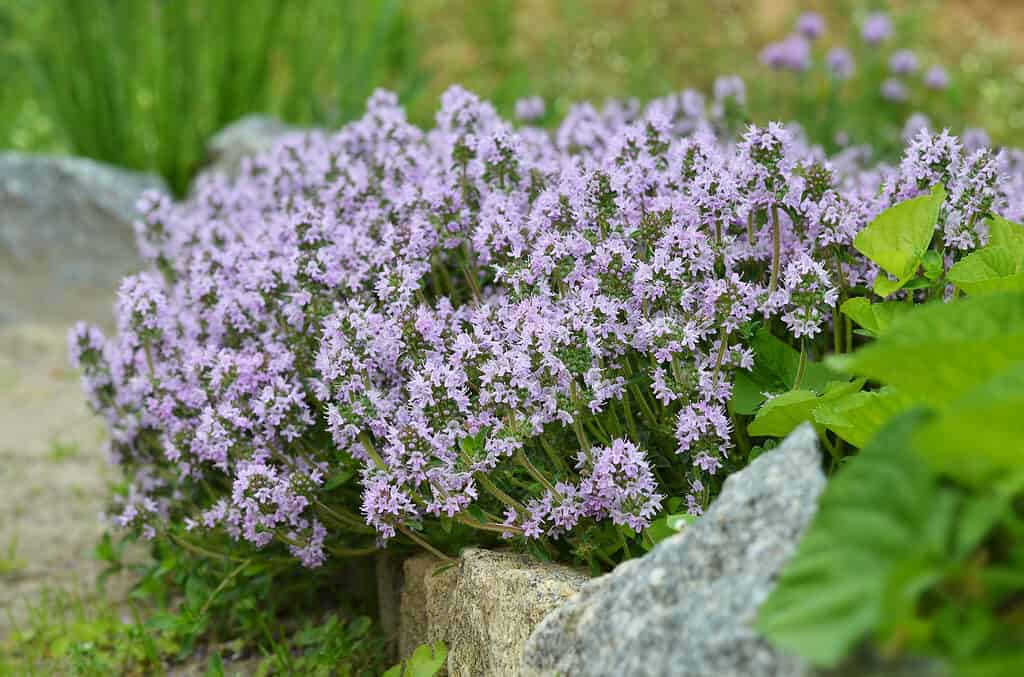
Another common name for this plant is “Elfin thyme”.
©iStock.com/Yuliia Bilousova
Thyme is another instance of a plant that is both an herb and a deer-deterrent. Though tiny, Breckland thyme produces beautiful and bright deer-resistant flowers. Colors are most often variations of pink to magenta. This low-growing plant is a great ground-cover plant and alternative to grass. You don’t have to worry about deer eating it due to its aromaticity.
If you’re thinking of planting some of this thyme, you can do so in just about any area. It is hardy down to 5°F.
20. Potentilla (Potentilla spp.)

Flowers in the genus
Potentillacan be yellow, white, orange, or red.
©Yating Kuo/ via Getty Images
With a name like “potential,” you might think this is another flower that deters deer because it’s somewhat stinky. In reality, this flower is just a bit fuzzier than the average deer cares to nibble on. Its texture is what keeps it from being eaten (for the most part). Potentilla produces five-lobed flowers and short, sword-shaped leaves. They are best grown in zones 2-7, making them relatively winter-hardy.
21. Baby Sage (Salvia microphylla)

The tube-shaped flowers attract pollinators with a proboscis, like hummingbirds.
©Wirestock/ via Getty Images
Another member of the Lamiaceae family, this herbaceous and aromatic plant will keep deer and other foraging critters away from your garden. This deer-resistant flower is evergreen and gives bright red, showy flowers in the summertime and possibly up to the first frost. Aim to grow this in warmer zones. Most sage plants don’t like temperatures below 20°F. Alternatively, you can grow this plant in containers and bring them inside for the winter.
22. Coneflower (Echinacea purpurea)

©iStock.com/Jasmina81
This might be a flower that is more commonly known by its genus name Echinacea. It is a common supplement many take both in capsule form and topically. As far as deer resistance goes, they can’t stand this plant. Gardeners love this plant for their hardiness, drought tolerance, and overall beauty. They also bring plenty of bustling pollinators to the yard. This can help with pollination of other plants in the garden, too.
Coneflowers can easily grow in a wide range (zones 3-9). Expect this perennial plant to grow up to 5 feet tall and 2 feet wide.
23. Columbine (Aquilegia caerulea)
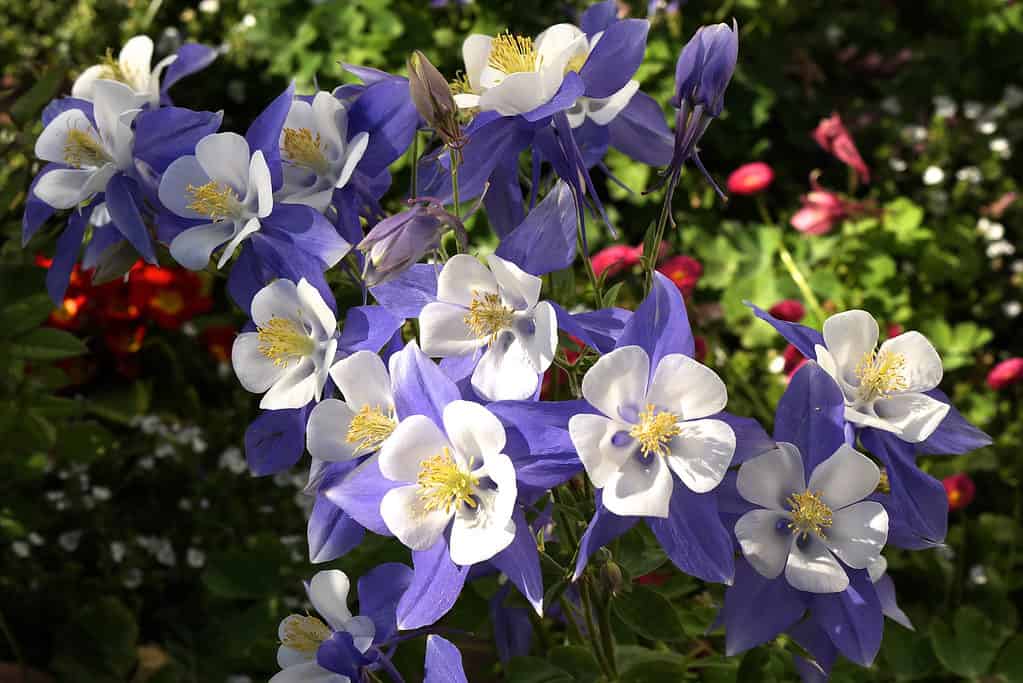
The strong fragrance of these flowers keeps the deer from approaching.
©iStock.com/Linda Jo Heilman
The flowers of a columbine plant are a spectacle. They feature two different colored flowers which gives the illusion there are two flowers on top of each other. On top of being attractive, columbine plants are also fairly drought tolerant. This makes them a good candidate for hotter and dryer regions (or for forgetful gardeners).
24. Lily of the Valley (Convallaria majalis)
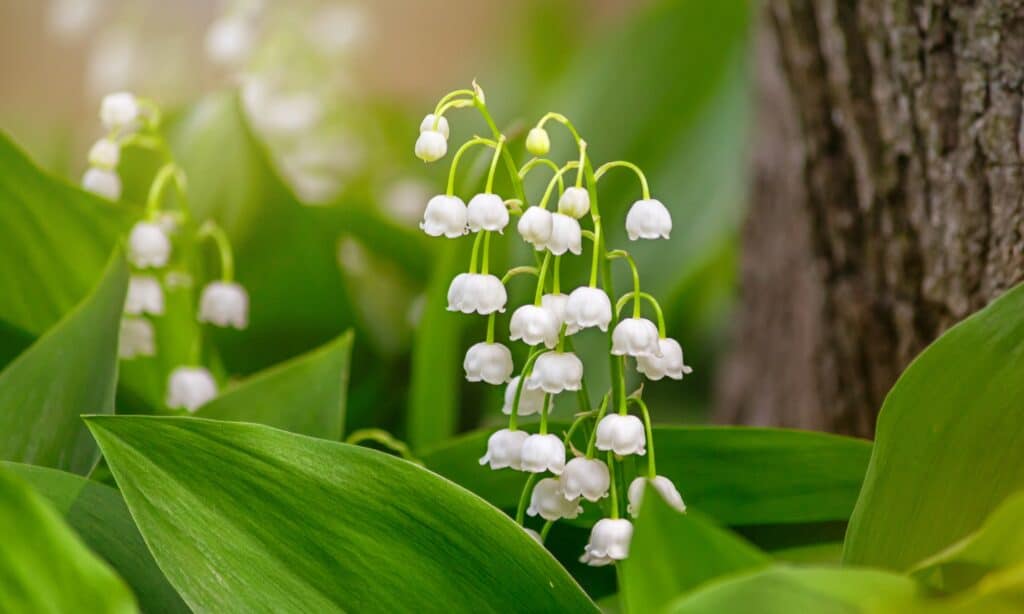
The lily of the valley is a member of the asparagus family!
©iStock.com/rustamank
A highly toxic and petite flower, deer know better than to try to chew on these. The tiny, upside-down bell-shaped flowers and all parts of the plant contain glycosides. These compounds can inhibit heart function. If you have any pets or young children running around in your garden, it is best to steer clear of planting this poisonous beauty.
25. Snapdragons (Antirrhinum majus)
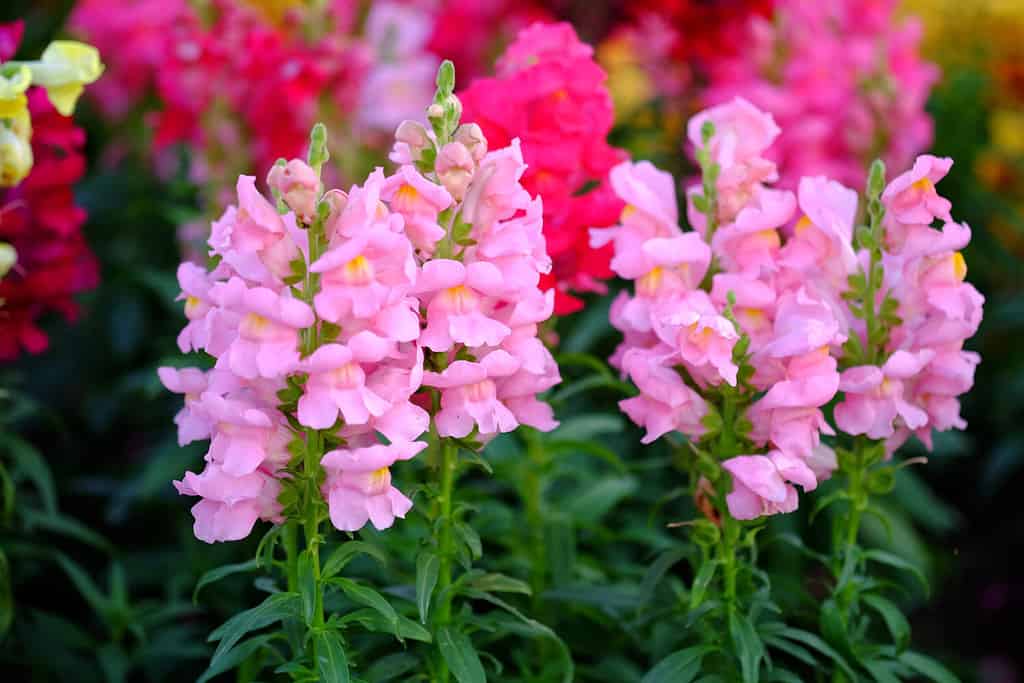
These are flowering plants with blooms that start in spring and persist into the fall.
©Nualanong/Shutterstock.com
Snapdragons are relatively tall flowers with some varieties reaching 4 feet in height. While the flowers are considered edible for humans, deer tend to stay away. Snapdragons prefer growing conditions found in zones 7-11, so this isn’t a suitable plant for many growers. However, if you are able to keep this deer-resistant plant in your garden, you’ll be rewarded with many blooms that can be almost all colors of the spectrum.
26. Lamb’s Ear (Stachys byzantina)
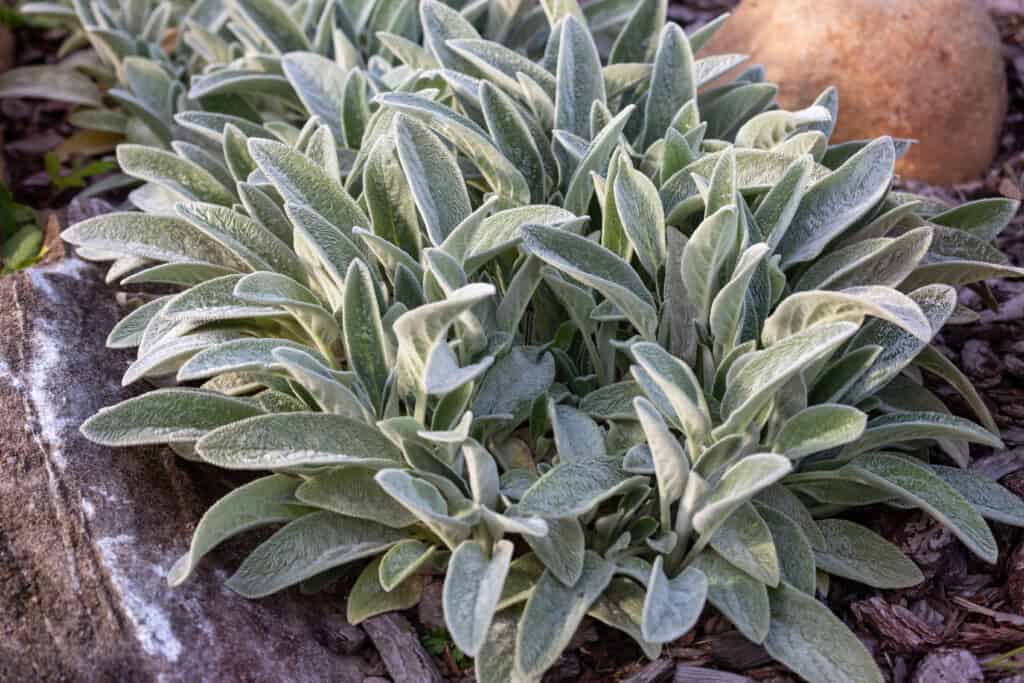
This is a quick-growing plant that easily spreads, so beware of its invasive status before planting.
©iStock.com/Yulia-B
The fuzzy nature of this plant is what earns them their common name as well as their reputation for being deer resistant. The foliage itself is interesting enough to warrant adding it to your garden. However, the flowers will be produced upon spikes high above the leaves. These aren’t necessarily show-stopping flowers, but the purple colors do stand out well against the sage or gray-colored leaves.
Lamb’s ear can grow 3 feet wide and half as tall in zones 4-9.
27. Yarrow (Achillea millefolium)
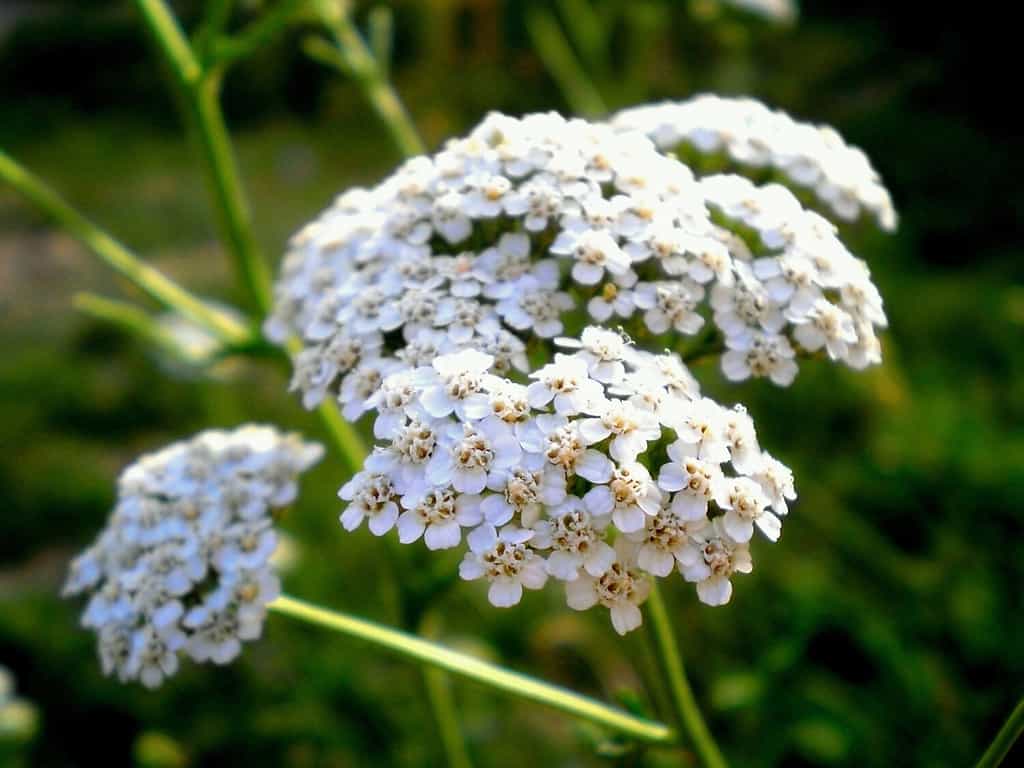
The unique inflorescence of the yarrow plant is rounded and flat-topped.
©SakSa/Shutterstock.com
Yarrow is a tall plant boasting petite, brightly colored blooms. Its strong scent keeps deer from getting too close to get a taste. While yarrow is a very pretty plant, caution should be used if you decide to add this to your garden. It can be quite invasive in some regions, and it’s a toxic plant to pets. If neither of those things are concerns, yarrow is a great addition to drought-prone areas or xeriscapes. It’s also a low-maintenance plant that will still attract some pollinator life into your home garden oasis.
28. Bluestar (Amsonia tabernaemontana)
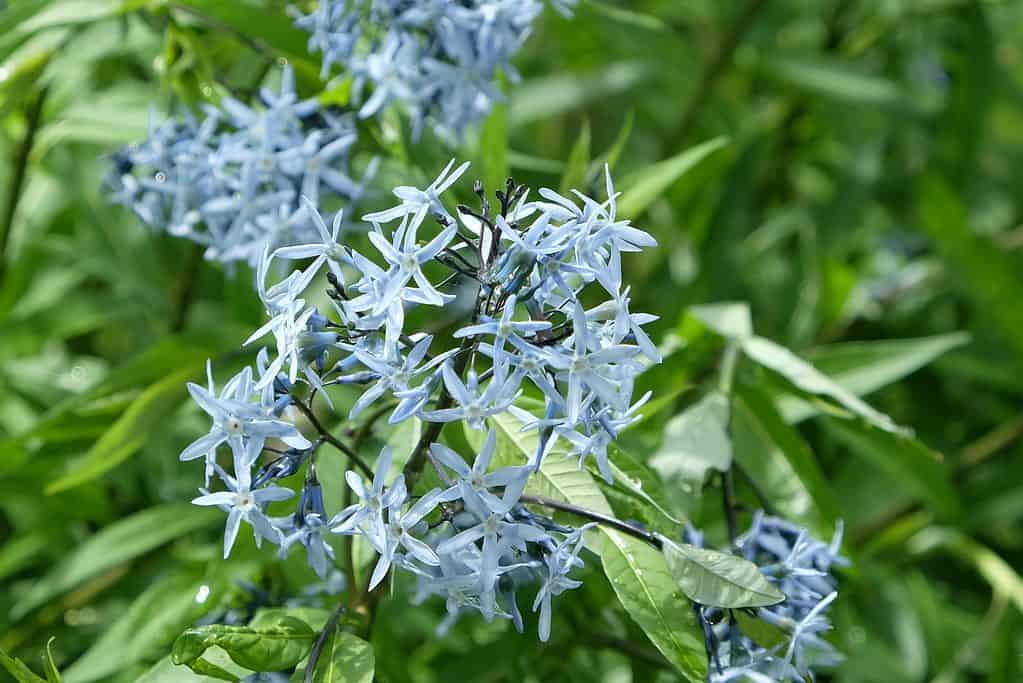
Even the stems appear an icy blue color on these interesting plants!
©Alex Manders/Shutterstock.com
The bluestar plant is a petite powerhouse. It’s deer-resistant and can tolerate many other harsh conditions, such as flooding, drought, shade, and bright light. It’s a very versatile and attractive addition to a garden. The growth habit of bluestar is somewhat small and compact, giving it a great place along garden beds and edges.
Bluestar grows well in zones 4-9 and flowers in the spring. Their small light blue flowers attract bees and other beneficial insects to your garden.
29. Yellow Alyssum (Aurinina saxitilis)
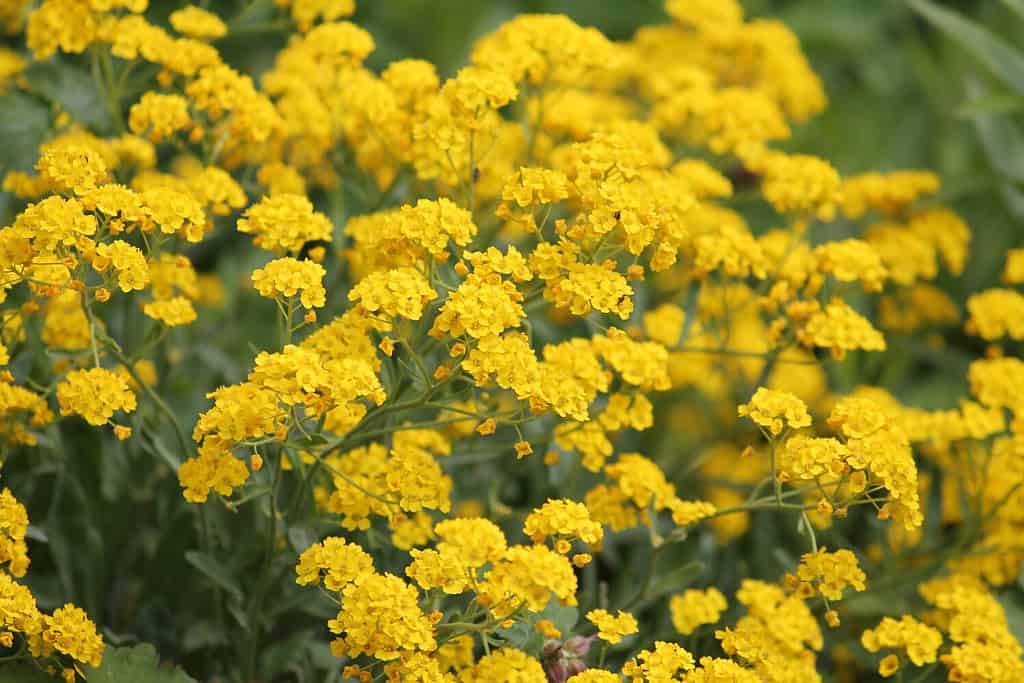
A common name for this plant is “Basket of Gold”.
©Kazakov Maksim/Shutterstock.com
A brightly colored wall of flowers is what you’re in store for if you plant yellow alyssum. This is another perfumed plant with a hardy growing range of zones 3-7. Look for the sunny blooms in the spring, but don’t bother looking for deer; they won’t be interested in this “smelly” plant.
30. Sea Holly (Eryngium planum)
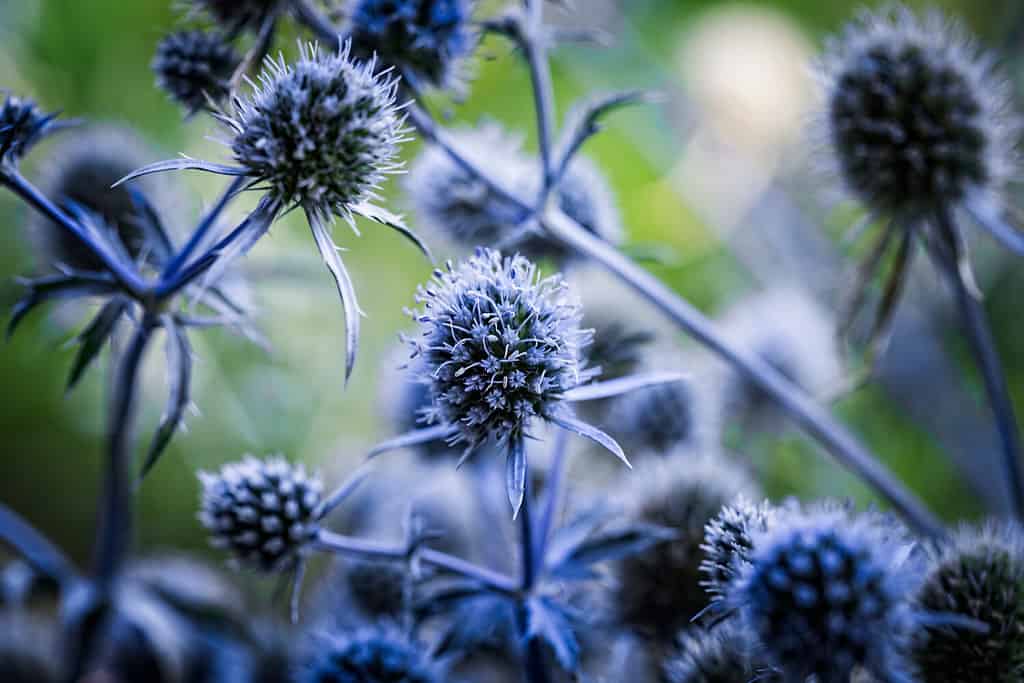
Sea holly can grow well in rock gardens and coastal areas.
©Kateryna Mashkevych/Shutterstock.com
Pretty to look at, but not fun to touch. The spiny stems and flowers of sea holly make this plant unapproachable for not only deer but even people! While this is often an addition to bouquets due to its beautiful blue color, don’t go in too close for a smell. The spiky nature of this plant ensures nobody gets too close more than once.
These are perennial plants in zones 4-9, though the species E. alpinum can survive in as cold a zone as zone 2.
31. Common Milkweed (Asclepias syriaca)

Milkweed grows large heads of individual flowers that can feed many pollinators at the same time.
©iStock.com/mr_coffee
Much like the butterfly bush, milkweed will also attract butterflies and similar pollinators to your garden. This plant is of particular importance to the monarch butterfly, which needs milkweed to feed off of in its larval stage.
This plant exudes latex, which is why it is called “milkweed”. This latex is bitter-tasting and poisonous and is not a preference for deer and other animals like rabbits. You can grow milkweed in zones 4-9. Milkweed can grow between 2-6 feet, depending on the species you get.
32. Penstemon (Penstemon spp.)

Choose a bright, full-sun area to best grow a penstemon plant.
©Nahhana/Shutterstock.com
Also known as “beardtongues,” penstemons are tall plants that grow spikes of flowers. These flowers most often are blues or purples, though warmer color varieties can be found. Penstemon plants are resistant to deer and rabbit munching. Hummingbirds will be instantly attracted to these tube-shaped flowers.
To best grow penstemon varieties, grow in zones 4-10. Otherwise, they’re very tolerant plants of many conditions and can even handle a bit of neglect.
33. Coreopsis (Coreopsis spp.)

Coreopsis flowers are also called “tickseed” plants.
©iStock.com/dianaarturovna
If you’re looking for an easy, deer-resistant plant then go straight for planting a coreopsis. They’re low maintenance because they hardly require fertilizer and are very drought tolerant. Even the most forgetful gardener can successfully grow these daisy-like flowers. Coreopsis plants tend to have a bitterness that makes them pretty unpalatable to deer.
A coreopsis plant will flower in zones 4-9 during the late spring into summer, and sometimes into the early fall months.
34. Marigolds (Tagetes spp.)
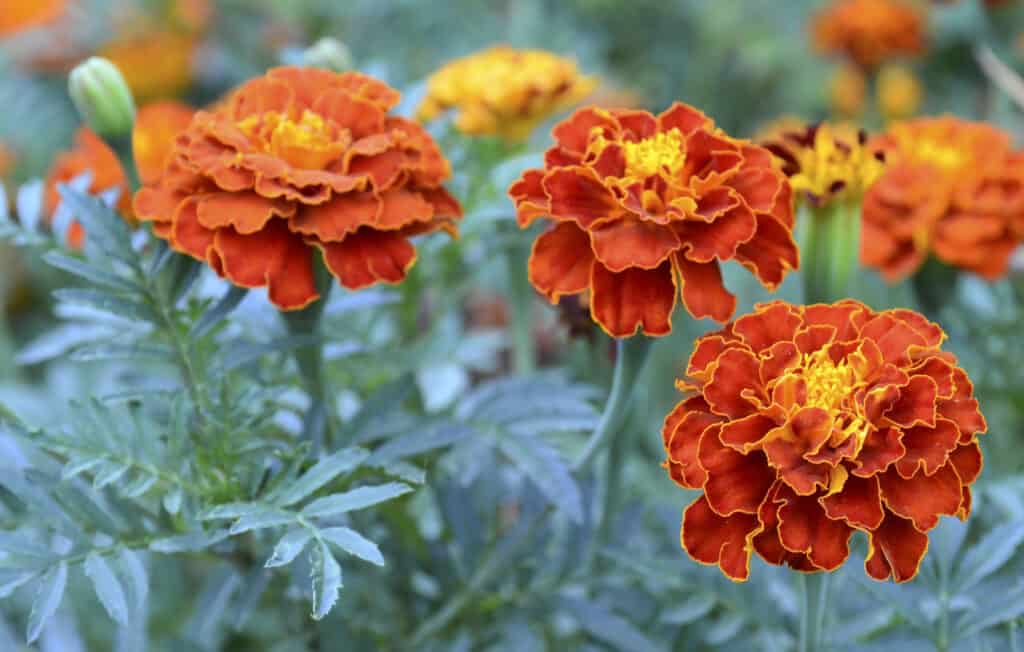
These gorgeous flowers are also quite pest-free.
©iStock.com/svf74
These orangey-red flowers brighten up just about any garden space. A marigold‘s cheery color is punctuated by deep green, frond-like leaves. They’re also very fragrant plants which tends to keep deer and other scent-sensitive grazing animals away. If you want to plant some marigolds, you can do so in almost any zone! They can grow almost 4 feet tall and 2 feet wide, so be sure to have ample space for it to grow out before planting.
35. Shasta Daisy (Leucanthemum × superbum)

Daisies like the shasta daisy can grow quite well in nutrient-poor soils.
©iStock.com/ChristySturm
A shasta daisy looks like a larger chamomile flower. These are deer-resistant flowers thanks to their somewhat hairy texture. While these flowers might endure some occasional grazing by a hungry deer, they’re very hardy flowers and can take a bit of damage without dying off.
Shasta daisies are long-lasting bloomers when living in zones 5-9. Expect the cute white and yellow daisies to flower throughout the spring and into fall.
Thank you for reading! Have some feedback for us? Contact the AZ Animals editorial team.








